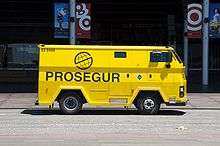Cash-in-transit


Cash-in-transit (CIT) or Cash/valuables-in-transit (CVIT) is the physical transfer of banknotes, coins and items of value from one location to another. The locations include cash centers and bank branches, ATM points, large retailers and other premises holding large amounts of cash such as ticket vending machines and parking meters.
Many cash in transit companies are private security companies that offer cash handling as part of their services. Loomis is today the only major CIT business that is fully dedicated to cash handling after the split from Securitas.[1][2] Brinks spun off its home security division setting the focus as well on cash handling.[3]
By law, the CIT companies are seen as logistic companies in the private security industry and therefore have to comply with transport and security legislation. In some countries, the transportation of cash has its own legislation (for example, Europe has varying CIT laws[4]). The CIT industry is regulated by national, regional and local legislation, social regulations and current practices. Responsible authorities are usually the Ministry of the Interior, the Ministry of Justice and the police. Legislation and regulations may impose requirements and restrictions on use of firearms, types of vehicles, minimum number of crew members, and use of Intelligent Banknote Neutralisation Systems.
CIT services can be carried out in soft-skinned, semi-armoured or armoured vehicles. The use of soft-skinned vehicles is normally only allowed when alternative security methods, such as Intelligent Banknote Neutralisation Systems, are also used. Such CIT is commonly referred to as “Light CIT”.[5]
Services
Inside CIT, the companies are specialized in the transportation and processing of cash and valuables, precious metals. They transport banknotes, coins, bulk cash, diamonds, non-personalised smart cards, non-personalised passports and other valuables. That is why, in many countries, the service was renamed ‘Asset handling’ or ‘Asset-in-transit’.
Cash Processing
Cash processing is an industrial process far removed from traditional banking activities and culture. The internal organization of cash handling within banks is often obsolete and inefficient, inherited from old bank organizations and further complicated by mergers, acquisitions and restructuring. This has led the majority of banks to opt for the outsourcing of wholesale cash processing.[6] Banks pursue several objectives when they choose to externalize their cash processing:
- Cut costs by streamlining processing structures and implementing higher throughput sorters.
- Achieve economies of scale thanks to larger and more efficient cash centres.
- Reduce investments required by an increasingly capital-intensive industry.
- Reduce the risks associated with cash.
- Optimize the supply chain management.
- Focus on the core business.
There are on the other hand inherent difficulties associated with outsourcing. One of them is the loss of control and the reliance on external providers. In some cases, banks no longer have the know-how in relation to cash handling.
Cash processing has evolved from a labor intensive activity focused on the transportation of cash to a capital-intensive industry offering end-to end solutions. Transport no longer constitutes the value added in the business but continues to structure the organization. The CIT’s footprint remains a key factor of selection by banks and retailers.
The industry is generally divided into the following activities:
- Processing
- ATM servicing
CITs are attempting to move away from this product oriented organization to customized sourcing models.
Major players
Five companies command nearly 60% of the global CIT market. (2010) [7] They are:
Few companies outside these five have cross-border operations. This is in part seen as a result of the significant cost to establish a CIT operation.
CIT guards
Most armored cars have two to three occupants:
- A driver, who is normally never allowed to leave the vehicle until it returns to the garage
- 1–2 guards who deliver the cash or valuables
Depending on the jurisdiction, the guards are armed with weapons. Most guards are issued with shotguns, while others carry handguns. Submachine guns and even assault rifles maybe equipped by those officers in some countries. These guards are required to have firearms training before they can carry them.
Six member states of the European Union prohibit weapons during cash-in-transit (CIT) operations.[8]
They are also required to wear bullet-proof vests[9] and/or ballistic helmets.
See also
References
- ↑ "Securitas Cash Handling Services announces new international brand identity "Loomis"". Securitas Group. Retrieved 18 Nov 2013.
- ↑ "Our Business". Loomis AB. Retrieved 18 Nov 2013.
- ↑ "The Brink's Company to Spin-Off Brink's Home Security to Shareholders". PR Newswire. Retrieved 18 Nov 2013.
- ↑ "A comparative overview of the legislations governing the Cash in Transit private industry in the 15 EU members" (PDF). Confederation of European Security Services. Archived from the original (PDF) on 2013-10-30. Retrieved 18 Nov 2013.
- ↑ "EU WHITE PAPER ON PROFESSIONAL CROSS BORDER TRANSPORTATION OF EURO CASH BY ROAD – EBF WISHLIST" (PDF). European Banking Federation. Retrieved 18 Nov 2013.
- ↑ "Session IV: Cash Outsourcing and Cash Recycling" (PDF). European Security Transport Association. Retrieved 18 Nov 2013.
- ↑ "Cash Solutions". G4S. Retrieved 18 Nov 2013.
- ↑ A comparative overview of the legislations governing the Cash in Transit private industry in the 15 EU members. CoESS / UNI-Europa joint Report. October 2004, p. 14.
- ↑ http://www.pssg.gov.bc.ca/securityindustry/worker/docs/armoured-car-guard.pdf